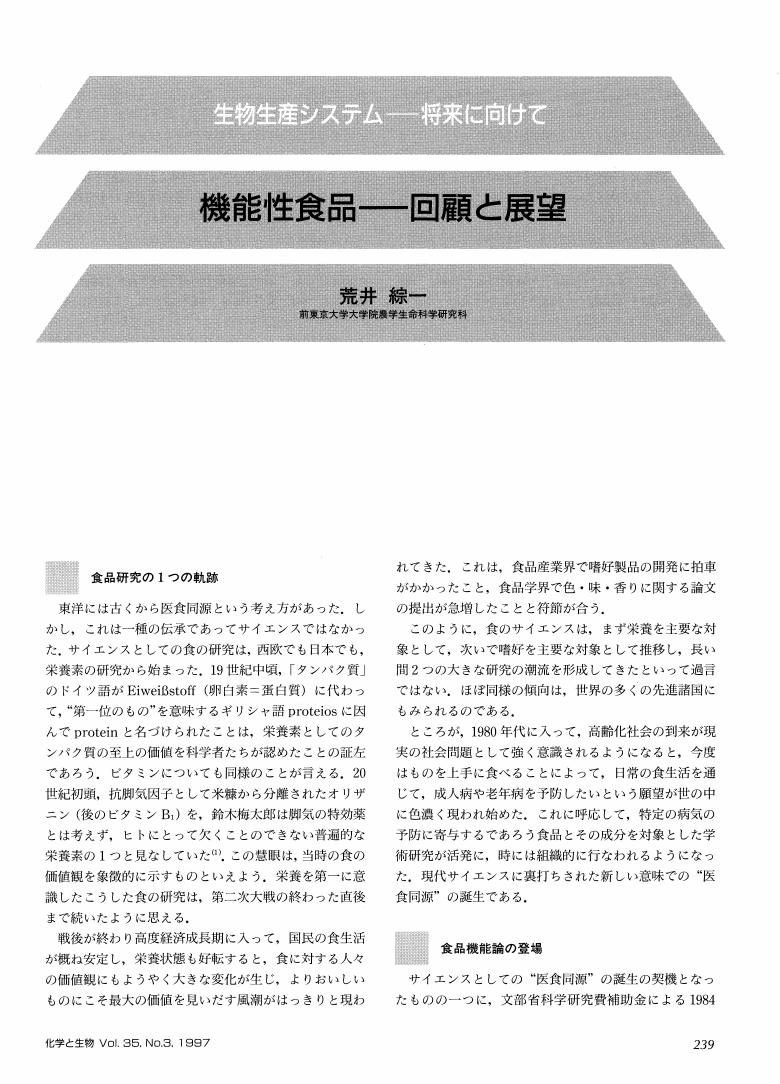48 0 0 0 OA 栄養素代謝におけるマグネシウムの重要性
- 著者
- 上原 万里子 石島 智子 松本 一朗 岡田 晋司 荒井 綜一 阿部 啓子 勝間田 真一 松崎 広志 鈴木 和春
- 出版者
- 日本海水学会
- 雑誌
- 日本海水学会誌 (ISSN:03694550)
- 巻号頁・発行日
- vol.64, no.4, pp.202-210, 2010-08-01 (Released:2011-08-10)
- 参考文献数
- 32
Magnesium (Mg) is essential for a diverse range of physiological functions, as it is involved in a variety of the body's biochemical processes. Mg deficiency, either from inadequate intake or from excess excretion, is often suspected to be associated with the development of many symptoms and diseases. The nutritional and physiological importance of Mg has already been well established. Mg was finally confirmed to be the most effective element for preventing several diseases, such as cardiovascular disease and metabolic disorders including obesity, diabetes and hypertension. Recently, many studies and meta-analyses have proved the above findings. Furthermore, a number of studies have reported the effects of Mg deficiency on carbohydrate, lipid, protein, vitamin and mineral metabolism. In this review, we discuss the effects of dietary-Mg deficiency on proteins, lipids, ascorbic acid and mineral metabolism, including kidney calcification and bone loss, in rodents. Furthermore, we performed transcriptome analysis to comprehensively understand the effects of dietary-Mg deficiency in rat livers and femora by using DNA microarray.
3 0 0 0 OA アボカドの食物繊維およびポリフェノールの分析と機能解析
- 著者
- 平澤 マキ 志村 晃一 清水 章子 村 清司 徳江 千代子 荒井 綜一
- 出版者
- 公益社団法人 日本食品科学工学会
- 雑誌
- 日本食品科学工学会誌 (ISSN:1341027X)
- 巻号頁・発行日
- vol.55, no.3, pp.95-101, 2008-03-15 (Released:2008-04-30)
- 参考文献数
- 21
- 被引用文献数
- 4 8
アボカドの食物繊維やポリフェノールの機能性を明らかにするために,その構成成分と特性を解析した.使用したアボカドは水溶性食物繊維5.23±0.53g,不溶性食物繊維11.3±0.71g(可食部100g当たり/無水物)を含んでいた.不溶性食物繊維はペクチン画分 : ヘミセルロース画分 : セルロース画分はそれぞれ20.6% : 43% : 36.4%であり,不溶性食物繊維は膨潤性が大きく,色素吸着能はローズベンガルにおいて高い値を示した.水溶性食物繊維は鉄吸着能も高く,WSPは優れた鉄保持能力をもつことが示唆された.また,アボカドの抗酸化性は果皮が最も強く,次いで種子,果肉の順であった.果皮にはポリフェノールが多く存在し,種子,果肉は少ないことが認められた.ポリフェノールの組成をGC-MSで測定したところ,カテキン,エピカテキン,クロロゲン酸類が同定され,これらが抗酸化性に寄与していると考えられる.果皮は未利用資源として新たな食品機能性素材に利用されることが期待される.
3 0 0 0 OA 細菌の氷核活性とその食品工業への応用
- 著者
- 荒井 綜一
- 出版者
- 公益社団法人 日本農芸化学会
- 雑誌
- 化学と生物 (ISSN:0453073X)
- 巻号頁・発行日
- vol.29, no.3, pp.176-182, 1991-03-25 (Released:2009-05-25)
- 参考文献数
- 25
- 被引用文献数
- 2
2 0 0 0 アボカドの食物繊維およびポリフェノールの分析と機能解析
- 著者
- 平澤 マキ 志村 晃一 清水 章子 村 清司 徳江 千代子 荒井 綜一
- 出版者
- Japanese Society for Food Science and Technology
- 雑誌
- 日本食品科学工学会誌 : Nippon shokuhin kagaku kogaku kaishi = Journal of the Japanese Society for Food Science and Technology (ISSN:1341027X)
- 巻号頁・発行日
- vol.55, no.3, pp.95-101, 2008-03-15
- 被引用文献数
- 8
アボカドの食物繊維やポリフェノールの機能性を明らかにするために,その構成成分と特性を解析した.使用したアボカドは水溶性食物繊維5.23±0.53g,不溶性食物繊維11.3±0.71g(可食部100g当たり/無水物)を含んでいた.不溶性食物繊維はペクチン画分 : ヘミセルロース画分 : セルロース画分はそれぞれ20.6% : 43% : 36.4%であり,不溶性食物繊維は膨潤性が大きく,色素吸着能はローズベンガルにおいて高い値を示した.水溶性食物繊維は鉄吸着能も高く,WSPは優れた鉄保持能力をもつことが示唆された.<BR>また,アボカドの抗酸化性は果皮が最も強く,次いで種子,果肉の順であった.果皮にはポリフェノールが多く存在し,種子,果肉は少ないことが認められた.ポリフェノールの組成をGC-MSで測定したところ,カテキン,エピカテキン,クロロゲン酸類が同定され,これらが抗酸化性に寄与していると考えられる.果皮は未利用資源として新たな食品機能性素材に利用されることが期待される.
- 著者
- 舟木 淳子 矢野 みどり 早渕 仁美 荒井 綜一
- 出版者
- 公益社団法人 日本食品科学工学会
- 雑誌
- 日本食品科学工学会誌 (ISSN:1341027X)
- 巻号頁・発行日
- vol.43, no.5, pp.546-551, 1996-05-15 (Released:2009-05-26)
- 参考文献数
- 20
- 被引用文献数
- 1 2
福岡県産豆腐味噌漬けの熟成過程における呈味,テクスチャーおよびタンパク質の変化について検討し,次のような結果を得た.(1) 豆腐味噌漬けは漬け込み日数が長くなるほどチーズ様の味が増し,柔らかくなることが官能検査およびレオメーターによる咀嚼試験から確かめられた.(2) 豆腐の総窒素に対する水溶性窒素の割合(タンパク質溶解率)は漬け込み前の水切り豆腐で13%であったものが漬け込み後2日で41%に達し,以後やや増加した.TCA可溶性画分中の遊離アミノ酸は熟成に伴って著しく増加し,漬け込み8日で水切り豆腐の26倍に達した.主な遊離アミノ酸はアルギニン,グルタミン酸,リジン,ロイシン等であった.(3) 電気泳動によりタンパク質の分解を調べた.熟成に伴ってβ-コングリシニンサブユニットおよびグリシニンの酸性サブユーットに対応する各バンドが消失し,20kd以下のバンドが増加した.(4) 走査電子顕微鏡により構造的変化を観察したところ,漬け込み日数の増加に伴ってタンパク質の網目構造が次第に崩れ,組織間の空間の拡がりが認められた.
1 0 0 0 OA 豚肉の長期熟成による官能的及び理化学的変化
- 著者
- 奥村 朋之 犬塚 雄介 西村 敏英 荒井 綜一
- 出版者
- 公益社団法人 日本畜産学会
- 雑誌
- 日本畜産学会報 (ISSN:1346907X)
- 巻号頁・発行日
- vol.67, no.4, pp.360-367, 1996-04-25 (Released:2008-03-10)
- 参考文献数
- 21
- 被引用文献数
- 1 2
本研究では真空包装した豚肉を,4°Cで30日間保存した時の官能的並びに理化学的変化を調べ,最適熟成期間について検討を行った.豚肉の味や香りは貯蔵期間20日目まで熟成が進むにつれ強くなり,好ましくなることが判明した.また,25日目まで微生物による劣化に問題はなかった.しかし,30日目に酸臭が発生し好ましくなかった.豚肉の軟らかさは熟成が進むにつれて増大した.また破断応力も30日目まで減少し続けた.遊離アミノ酸は30日目まで増加し続けたが,20日目以降増加割合が減少した.ペプチドは20日目まで増加し続けたが,それ以降の変化は認められなかった.これらの物質は,熟成による呈味向上に貢献していると推察された.イノシン酸は熟成により減少したが,20日目でも1.6μmol/gmeat残存しており,グルタミン酸との相乗効果により豚肉の呈味形成に寄与していると推察された.以上の結果から,豚肉を真空包装し4°Cで貯蔵した場合には,20日目の肉が官能的に最も優れていると結論された.
1 0 0 0 OA 機能性食品-回顧と展望
- 著者
- 荒井 綜一
- 出版者
- 公益社団法人 日本農芸化学会
- 雑誌
- 化学と生物 (ISSN:0453073X)
- 巻号頁・発行日
- vol.35, no.3, pp.239-244, 1997-03-25 (Released:2009-05-25)
- 参考文献数
- 15
- 被引用文献数
- 2
1 0 0 0 OA 塩加減のサイエンス
- 著者
- 畑江 敬子 荒井 綜一
- 出版者
- 日本海水学会
- 雑誌
- 日本海水学会誌 (ISSN:03694550)
- 巻号頁・発行日
- vol.61, no.4, pp.226-229, 2007 (Released:2013-02-19)
The salty taste strength of foods may not necessarily depend on their NaCl contents. The saltiness we feel often varies according to the physical properties of the foods that function in the mouth. However, no clear scientific information has been available up to the present.With it as a background, we undertook a project research aimed at elucidating the relationship between the NaCl contents of foods and their saltiness. The following foods with different NaCl contents were prepared: egg white gel, 0.4-1.2% NaCl; soy protein isolate gel, 1.0, 2.0% NaCl; soy protein curd (tofu), 0.5, 1.0% NaCl; and agar gel, 0.8, 1.0% NaCl. Sensory tests using well-trained panel members were first carried out with these food preparations to define their saltiness in terms of salty taste efficiency ratio (STER). The tests gave the STER values ranging from 0.58 to 1.10. Physical data were also measured with the foods to obtain several of their parameters involving gelling properties. It was then tried to correlate the physical data with the STER values. We could not find any significant correlation as far as the same food was tested irrespective of its different NaCl content. However, all the foods we prepared were comprehensively submitted to the physical parameter-sensory score analysis, significant relation appeared (R2: 0.83) which were clearly represented by an equation as a function of breaking stress value. It was also suggested that the STER differences were generally larger between foods than within a food having different NaCl contents.This project research is apparently the first that objectively expresses the saltiness of foods in relation to their physical properties. It would contribute to our scientific aspect on how the proper saltiness for cooking of foods varies depending on the physical properties.

